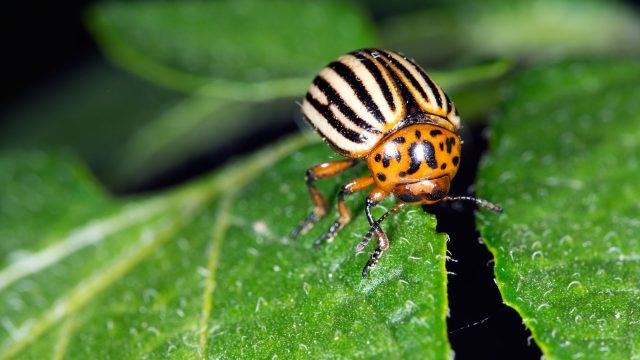30
Oct
Despite a Beetle’s History of Resistance to Insecticides, EPA Is Pushing Genetically Engineered Pesticide

(Beyond Pesticides, October 30, 2023) TAKE ACTION. It is said that the definition of insanity is doing the same thing over and over again and expecting a different result. And so it goes with the U.S. Environmental Protection Agency’s (EPA) proposal to register a new genetically engineered pesticide for the Colorado Potato Beetle (CPB); this time with a pesticide that has not been fully evaluated for its adverse effects to people and the environment. [Submit a public comment before comment period ends today, October 30, 2023.]
Chemical-intensive agriculture has failed to control CPB since resistance to DDT was identified in 1952 and has continued with every family of pesticides since then. CPB has been dubbed the billion-dollar-bug because of the investment in failed attempts of chemical manufacturers to control the insect, the profits generated by chemical companies despite this failure, and the resulting losses for chemical-intensive farmers—not to mention government expenditures for the registration of chemicals that have short efficacy, pollution costs associated with chemical production and use, and lost ecosystem services. But, EPA is at it again, registering a new novel pesticide active ingredient, Ledprona, which raises the stakes on potential harm. The only winners in this ongoing failure are the chemical manufacturers that continue to reap huge economic benefits from the sale of their highly toxic pesticides. Meanwhile, according to research published in Molecular Biology and Evolution (2022) and hundreds of other scientific articles over the years, “This is the case with insect “super-pests,” which repeatedly evolve insecticide resistance even as they are faced with completely novel insecticides, thus perpetuating the arms race that defines the pesticide treadmill.” And yet, EPA is still at it, despite the success of alternative strategies with organic management systems.
Take Action: Tell EPA not to register Ledprona without complete data supporting its safety.
While researchers and the chemical industry keep trying to develop new “silver-bullet” chemicals for controlling CPB, EPA has ignored methods of agricultural management that work without reliance on toxic chemicals. Advocates say that this newest proposed pesticide exemplifies the worst of EPA’s pesticide registration program, governed by its Office of Pesticide Programs, because there are alternative methods and the risks of Ledprona have not been found to be “reasonable”—even under a weak federal pesticide law, the Federal Insecticide, Fungicide, and Rodenticide Act (FIFRA).
The University of Minnesota Extension, in its publication “Organic management recommendations for Colorado potato beetle,” describes the range of methods that are integrated into an organic systems approach not reliant on pesticides. It includes crop rotation, early maturing varieties, mulching systems and habitat for natural enemies like ladybugs and parasitic wasps, trapping, and a naturally occurring soil bacterium.
FIFRA requires that EPA register a pesticide only if it determines that the pesticide “will perform its intended function without unreasonable adverse effects on the environment.” EPA admits that it is basing its proposed registration decision solely on data the registrant GreenLight Biosciences submitted to fulfill requirements for its prior application for an experimental use permit (EUP), without any additional data. However, there are far fewer data requirements for approval of an EUP than are required for a full registration.
Ledprona’s use of RNAi makes it unique and unlike any other insecticide sprayed on fields. The use of new technology makes it especially imperative to examine all required data for any potential unintended consequences. Since these novel pesticides may be applied by plane, EPA must thoroughly assess the real-world impacts of pesticide drift. This technology, which penetrates plant tissues and leaves traces in the soil, can cause widespread indiscriminate poisoning—as has been seen with bees, butterflies, birds, and the larger catastrophic decline of insect populations, called the “insect apocalypse.” The effects, especially on threatened and endangered species like the American burying beetle, Hungerford’s crawling water beetle, the Northeastern beach tiger beetle, and the Puritan tiger beetle, must be evaluated. These species are found near potato production areas close to where the Experimental Trials were being conducted and could be direct casualties of this new biopesticide.
In addition, researchers from the U.S. and Switzerland have published findings, a beginning assessment of how the use of this new category of pesticides—RNAi, delivered in double-stranded RNA (dsRNA) molecules—might impact soils and nontarget microorganisms in the soil. The coauthors (Kimberly M. Parker, PhD, et al.) note that, “The ecological risk assessment of these emerging pesticides necessitates an understanding of the fate of dsRNA molecules in receiving environments, among which agricultural soils are most important.” Their research has continued, finding that “Due to the ability of DOM (dissolved organic matter) to both bind and suppress the enzymatic degradation of RNA, RNA biodegradation may be slowed in environmental systems with high DOM concentrations, which may increase its persistence.”
Beyond Pesticides is advising the public to Tell EPA not to register Ledprona without complete data supporting its safety.
All unattributed positions and opinions in this piece are those of Beyond Pesticides.
Sources. Molecular Biology and Evolution (2022), Science Daily, EPA Docket ID No. EPA-HQ-OPP-2021-0271.










